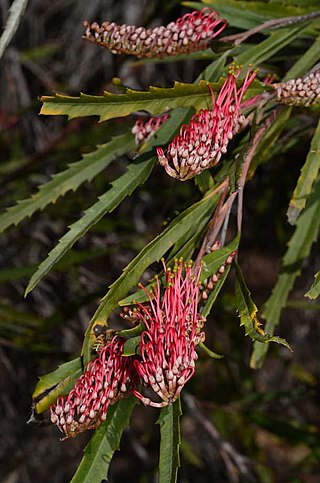
Grevillea longifolia, commonly known as fern-leaf spider flower, is a species of flowering plant in the family Proteaceae and is endemic to the Sydney Basin in New South Wales. It is an erect to spreading shrub with narrowly egg-shaped to almost linear leaves, and toothbrush-like groups of pinkish-fawn flowers with a pink to red style. It is fairly readily grown in gardens.

Orites excelsus, commonly known as prickly ash, mountain silky oak or white beefwood, is a species of flowering plant in the family Proteaceae and is endemic to eastern Australia. It is a medium-sized to tall rainforest tree with oblong to lance-shaped leaves, variously lobed and with teeth on the edges. The flowers are white and arranged in leaf axils in spikes that are shorter than the leaves.
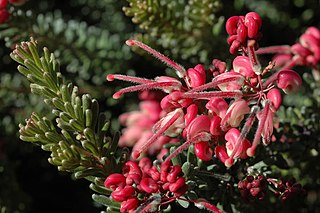
Grevillea lanigera, commonly known as woolly grevillea, is a species of flowering plant in the family Proteaceae and is endemic to south-eastern continental Australia. It is a spreading shrub with narrowly oblong to more or less linear leaves and clusters of pink to red, and cream-coloured flowers.

Grevillea crithmifolia is a species of flowering plant in the family Proteaceae and is endemic to the south-west of Western Australia. It is a dense shrub with linear leaves, divided leaves with narrowly oblong lobes, or both, and clusters of pale pink to creamy-white flowers.
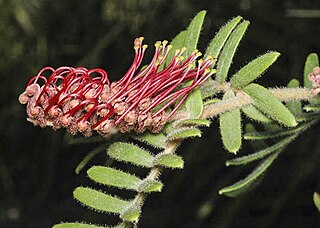
Grevillea caleyi, also known as Caley's grevillea, is a critically endangered species of flowering plant in the family Proteaceae and is endemic to a restricted area around the Terrey Hills and Belrose area in New South Wales. It is an open, spreading shrub, growing up to 4 m (13 ft) tall with deeply divided leaves with linear lobes, and fawn flowers with a maroon to red style.

Grevillea agrifolia, the blue grevillea, is a species of flowering plant in the family Proteaceae and is native to the north of Western Australia and parts of the Northern Territory. It is a shrub or tree with narrowly oblong leaves with the narrower end towards the base, and creamy-yellow flowers.
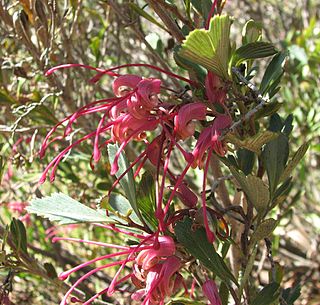
Grevillea pectinata, commonly known as comb-leaf grevillea, is a species of flowering plant in the family Proteaceae and is endemic to the south of Western Australia. It is a spreading shrub with divided, comb-like leaves and mauve-pink to red and cream-coloured to yellow flowers with a red to deep pink style.

Persoonia rigida, commonly known as the rigid-, hairy- or stiff geebung, is a species of flowering plant in the family Proteaceae and is endemic to south-eastern Australia. It is an erect to low-lying shrub with hairy young branchlets, lance-shaped to spatula-shaped leaves that are hairy when young, and yellow flowers borne in groups of up to twenty on a rachis up to 90 mm (3.5 in) long that continues to grow after flowering.

Hakea tephrosperma commonly known as hooked needlewood, is a shrub or small tree species in the family Proteaceae. It has cream flowers, needle-shaped leaves and is one of the taller species adaptable for dry to temperate locations.

Grevillea floribunda, commonly known as seven dwarfs grevillea, is a species of flowering plant in the family Proteaceae and is endemic to eastern Australia. It is a spreading shrub with oblong to egg-shaped leaves with the narrower end towards the base and groups of six to twenty flowers covered with rusty brown hairs.
Grevillea obtusiflora is a species of flowering plant in the family Proteaceae and is endemic to a small area of eastern New South Wales. It is a low, spreading to erect shrub with many stems, narrowly elliptic to oblong or linear to narrowly egg-shaped leaves with the narrower end towards the base, and pinkish-red and cream-coloured flowers with a red style.

Grevillea quercifolia, commonly known as the oak-leaf grevillea, is a species of flowering plant in the protea family and is endemic to the southwest of Western Australia. It is a straggly to sprawling shrub usually with pinnatifid or serrated leaves, and oval to cylindrical clusters of pale to deep pink flowers.

Stenocarpus cunninghamii, commonly known as little wheel bush, is a species of flowering plant in the family Proteaceae and is endemic to northern Australia. It is a shrub or small tree with simple, narrow elliptic or lance-shaped adult leaves, groups of pale yellow or white flowers and woody, linear follicles.

Grevillea triternata is species of flowering plant in the family Proteaceae and is endemic to New South Wales. It is a dense, compact shrub with divided leaves, the end lobes sharply pointed, linear to narrowly triangular, and cylindrical clusters of white flowers with a cream-coloured to pale yellow style.
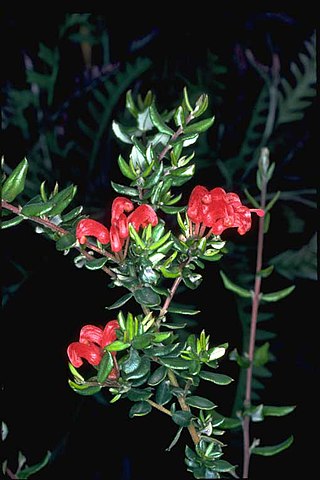
Grevillea depauperata is a species of flowering plant in the family Proteaceae and is endemic to the south-west of Western Australia. It is a low, dense, spreading shrub with oblong or egg-shaped leaves and clusters of red to orange flowers.

Grevillea fasciculata is a species of flowering plant in the family Proteaceae and is endemic to the south-west of Western Australia. It is a low, often spreading shrub with narrowly elliptic to more or less linear leaves and erect clusters of red and orange or orange and yellow flowers.

Grevillea anethifolia, commonly known as spiny cream spider flower, is a species of flowering plant in the family Proteaceae and is endemic to continental Australia. It is an erect shrub with hairy branchlets, lobed leaves, the lobes sharply pointed, and white to pale yellow or cream-coloured flowers.

Grevillea baxteri, commonly known as the Cape Arid grevillea, is a flowering plant of the family Proteaceae and is endemic to the south-west of Western Australia. It is an erect to spreading shrub with pinnatipartite leaves and greenish to fawn or creamy-orange flowers.
Grevillea cunninghamii is a species of flowering plant in the family Proteaceae and is endemic to the north of Western Australia. It is a shrub with egg-shaped leaves with sharply-pointed teeth on the edges, and clusters of red flowers.

Grevillea angulata is a species of flowering plant in the family Proteaceae and is endemic to the Top End of the Northern Territory. It is a spreading to erect shrub with pinnatifid or toothed leaves and cream-coloured flowers.

































